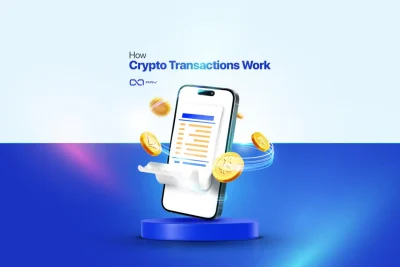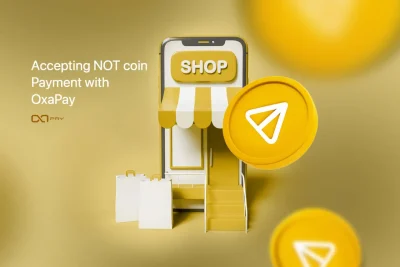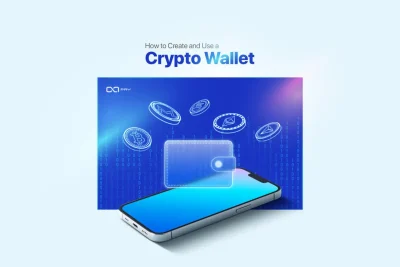Cryptocurrency operates on trustless systems, networks where transactions don’t rely on banks or intermediaries. Instead, they rely on cryptography. At the heart of this system lie two essential components: public keys and private keys.
Whether you’re sending Bitcoin, signing a message, or accessing a decentralized wallet, public and private keys are what make secure transactions possible. But how do they work? And why is it so important to understand them?
This article explains everything you need to know about public and private keys, from how the system generates them to how they protect your assets.
What Is a Public Key?
A public key is a cryptographic code that allows others to send cryptocurrency to your address.The system derives it from your private key through a mathematical process, and it remains publicly visible, similar to an email address or bank account number. Anyone can know your public key, and it doesn’t pose any security risk on its own.
In most blockchains, your public key is either:
- The actual address (e.g., Ethereum)
- Or used to generate your wallet address (e.g., Bitcoin)
Key Properties:
- You can share it freely.
- People use it to send funds to your wallet.
- It serves as your identity on the blockchain.
What Is a Private Key?
A private key is a secret code that gives you access to your cryptocurrency. It’s mathematically related to your public key, but the process is one-way, meaning no one can reverse-engineer your private key just by knowing your public key.
Think of it as your password or signature. If someone gets your private key, they can send your funds anywhere, and there’s no undo button.
Wallet software usually stores private keys as long strings of numbers and letters, or as seed phrases, a list of 12 or 24 words.
Key Properties:
- You must keep it secret at all times.
- It allows you to sign transactions.
- Whoever holds the private key controls the funds.
How Are Public and Private Keys Created?
Algorithms like the Elliptic Curve Digital Signature Algorithm (ECDSA), commonly used in Bitcoin and Ethereum, generate key pairs.
Here’s a simplified version of the process:
- The system generates a secure random number, which becomes your private key.
- It then uses that private key to mathematically derive your public key.
- In some blockchains, the system hashes the public key to create your wallet address.
Because the math is asymmetric, even if someone has your public key, they can’t calculate your private key from it, this is what makes crypto secure.

How Do They Work Together?
When you send crypto, you use your private key to sign the transaction. This signature shows that the owner of the funds authorized the transaction, without revealing the private key itself.
The network then uses your public key to verify the signature. If the signature checks out, the transaction is valid.
This process enables:
- Secure authentication without passwords
- Digital signatures for messages or smart contracts
- Ownership of assets on decentralized networks
Common Formats: Keys, Addresses, and Seed Phrases
Crypto wallets often abstract key management, but it’s useful to know the formats involved:
- Private Key: A hexadecimal string (e.g., 5J2m…), or derived into a seed phrase (12–24 recovery words).
- Public Key: The system derives it from the private key, and it can appear in either compressed or uncompressed form.
- Wallet Address: The shortened, hashed version of the public key used for receiving payments (e.g., 0x123… on Ethereum)
Public and Private Keys in Different Use Cases
Developers and users apply these keys not just in wallets but throughout the entire crypto ecosystem:
- Wallet access: Proving ownership and authorizing transactions.
- Smart contract interaction: Signing approvals for DeFi apps and dApps.
- Multi-signature wallets: Requiring multiple private keys to authorize a transaction.
- Cold storage: Private keys are kept offline to eliminate hacking risk.
- Messaging: Some systems use public/private keys to encrypt and verify secure messages.

What Happens If You Lose a Key?
- Lose your private key? Your funds are gone, forever. There is no password reset in crypto.
- Lose your public key? No problem, you can regenerate it from the private key.
That’s why backing up your private key or seed phrase is absolutely essential.
Security Tips: How to Keep Your Private Key Safe
Real Losses Caused by Private Key Mistakes
In 2013, James Howells, a British IT professional, accidentally discarded a hard drive containing the private keys to 7,500 Bitcoin. Though his wallet address is still visible on the blockchain, the funds remain permanently inaccessible. That mistake, made more than a decade ago, still haunts him, especially now that those Bitcoins are worth over $250 million.
Another example comes from 2020, when a DeFi user unknowingly shared a screenshot of his crypto wallet on Twitter. Unfortunately, his private key was visible in the background. Within minutes, bots scanned the image, extracted the key, and drained over $30,000 from his wallet. There was no warning, no recourse, and no way to recover the funds.
These stories illustrate a core truth of crypto: your private key is the single point of control over your assets. If it’s lost or leaked, even for seconds, it can lead to permanent, irreversible loss.
Best Practices: How to Protect Your Private Key
Whether you’re managing a few hundred dollars or millions in crypto, these best practices can help you keep your private key, and your funds, safe.
No legitimate service will ever ask for your private key. If someone claims they need it to “help” you, it’s a scam. Keep your private key and seed phrase secret, always.
2. Use a Hardware Wallet for Long-Term Storage
Hardware wallets like Ledger and Trezor store your private key offline, making them immune to online hacks. They’re ideal for holding significant amounts of crypto safely over time.
3. Avoid Storing Keys Digitally Without Encryption
Do not store your private key in plain text files, screenshots, or cloud storage services like Google Drive. If you must store them digitally, encrypt the file and store it on an offline or air-gapped device.
4. Keep Multiple Secure Backups
Write down your seed phrase and store it in at least two separate, secure locations (such as a fireproof safe or safety deposit box). Never keep all your backups in one place.
5. Beware of Phishing Sites and Fake Wallets
Double-check URLs, avoid downloading wallets from unverified sources, and never click on suspicious links. Many attacks are based on tricking users into entering their private key on fake interfaces.
6. Use a Strong PIN or Passphrase
If your wallet supports it, use an extra passphrase or PIN in addition to your seed phrase. This adds another layer of protection, even if someone gains access to your device.
7. Understand What You’re Signing
Some smart contract scams trick users into signing approvals that give away access to funds. Always double-check transactions and approvals, especially in DeFi apps.
Final Reminder
Your private key isn’t just a password, it’s the only key to your crypto. There’s no “forgot my password” button in blockchain systems. No support ticket can recover a lost key. Security in crypto is personal, and ownership comes with responsibility.
Treat your private key like your digital life savings, because, in many ways, it is.
Final Thoughts
Understanding public and private keys isn’t optional, it’s fundamental. These key pairs are the foundation of trust, ownership, and security in blockchain systems.
Whether you’re just starting out or already working with crypto, taking the time to understand how keys work will help you stay secure, avoid costly mistakes, and get the most out of what crypto offers.
In crypto, your private key is your power. Guard it well.
Want to accept crypto without giving up control of your keys?
Discover how the crypto payment gateway OxaPay helps you receive payments directly with full transparency. You can also manage your assets easily using the OxaPay wallet, fast, secure, and optimized for crypto businesses.




